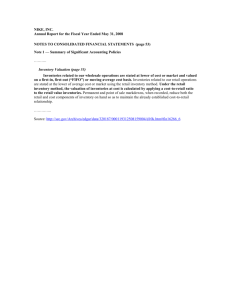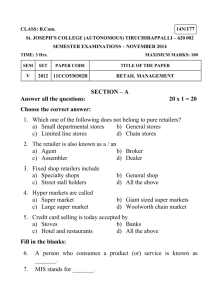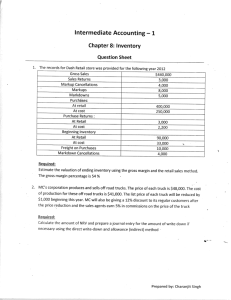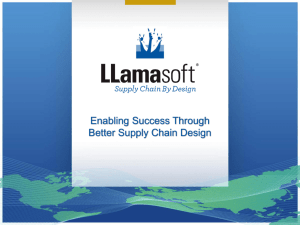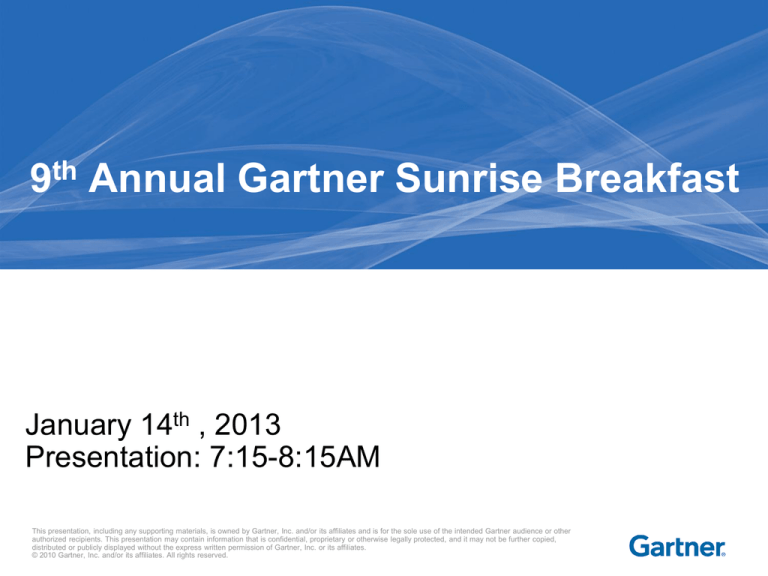
9th Annual Gartner Sunrise Breakfast
January 14th , 2013
Presentation: 7:15-8:15AM
This presentation, including any supporting materials, is owned by Gartner, Inc. and/or its affiliates and is for the sole use of the intended Gartner audience or other
authorized recipients. This presentation may contain information that is confidential, proprietary or otherwise legally protected, and it may not be further copied,
distributed or publicly displayed without the express written permission of Gartner, Inc. or its affiliates.
© 2010 Gartner, Inc. and/or its affiliates. All rights reserved.
NRF Welcome
1
Agenda Overview
• NRF Introduction/Welcome
• Gartner Overview
• Moderator/Panel Introduction
• Gartner Retail Research Observations
• Panel Q & A
2
Gartner Overview
Kevin Sterneckert
VP Research
Consumer Value Chain
3
Gartner delivers the technology-related and
supply chain insight necessary for our clients
to make the right decisions, every day.
4
Helping you achieve demonstrable business results
730
60,000
analysts
clients
across 80
10,800
enterprises
countries
450
300,000
consultants
Gartner is uniquely positioned
to deliver a depth, breadth and
quality of IT expertise you
won’t find anywhere else
client
1,500
interactions
engagements
65% of
In-depth retail
industry
Fortune 1000
80% of
coverage
Global 500
55
5,500
conferences
benchmarks
3,800
CIOs
10,000 media
inquiries
5
“Gartner acts as an
extension of my staff
and as an intelligent
filter to the oceans of
information I need to
track and monitor. With
Gartner, I get opinions
that are objective,
unbiased and candid.”
JOSEPH D. “JODY” GILES
CIO, Under Armour
Format & Panel Introduction
Kevin Sterneckert
6
Retail Trends 2013
• Jeff Roster
• VP, Industry Market Strategies, Retail
• Jeff.roster@gartner.com
7
A Day in the Life of an Analyst
Source: Gartner Forecast Q2, 2011
TotalTotal
U.S. U.S.
IT Retail
Software
Services
Spend
Spend
Total
U.S.
Retail
IT Spend
Millions of Dollars
80,000
Percent
9
70,000
8
60,000
50,000
7
40,000
6
30,000
20,000
5
10,000
0
4
2012
Total IT Spend
2013
Avg. Growth Rate
A Nexus of Forces
Extreme
Behavior
Global Class
Delivery
Pervasive
Access
"Big"
Context
Are Retailers Asking About the Nexus of
Forces?
Technology and Telecom
9%
Media
3%
7%
Education
3%
5%
Services
3%
6%
Banking, Finance & Ins
7%
Government
7%
Energy & Utilities
Manufacturing
6%
Healthcare
6%
Total
2%
2%
0%
1%
6%
1%
7%
1%
7%
2%
1%
6%
2%
1%
6%
2%
8%
1%
7%
2%
7%
1%
6%
2%
8%
Transportation
2%
9%
8%
6%
2%
5%
2%
9%
2%
Retail
10%
1%
1%
7%
10%
1%
15%
% of Inquiries Mentioned "mobile"
% of Inquiries Mentioned "social"
% of Inquiries Mentioned "cloud"
% of Inquiries Mentioned "big data"
11
20%
25%
Retail Marketing Becomes More Strategic
Q: Would you describe Marketing in your organization as more tactical or more strategic in
nature?
Mean score
1 - 2 More Tactical
3 to 5
6 - 7 More Strategic
Retail Industry
(out of 7)
(n=35)
Marketing 2 years ago
Marketing today
Marketing 2 years from now
20%
69%
9%
11%
54%
6% 14%
3.8
4.9
37%
6.1
80%
All Industries
(n=512)
23%
Marketing 2 years ago
Marketing today
Marketing 2 years from now
10%
8%
1=More Tactical
Source: Gartner survey conducted May, 2012
Copyright 2012, Gartner, Inc. All rights reserved.
64%
13%
64%
32%
27%
60%
3.7
4.6
5.5
7=More Strategic
The Year of Customer Innovation
Robert Hetu
Research Director
Industry Research
Retail
13
What Innovation Really Means in 2013
Key Issues
• How will consumerization impact retail
innovation?
• What changes will your business need to
make?
• How should you involve the customer in
innovation?
14
Consumerization is irreversible and is
leading to the end of consumers as we
know them
Technology is accommodating customer
behaviors
•Communicate
•Collaborate
•Co-create
•Customize
Customers Are Increasingly in Control of
Your Business Model
• Consumers will become even
more powerful and will change
retail business models
• These business models will be
consumer-centric — that is,
with the consumer controlling
the way in which the models
evolve
The Evolving Customer-Centric Business
Model for Retail
Curator
Aggregator
Consumer
Designer
Builder
Technology is Not the Answer!
Socialize
and
Diffuse
Define
Scope
Implement
Champion
Develop
Evaluate
and
Select
Capture
Ideas
Key Takeaways on Customer Innovation
Open up the innovation process:
1. Understand that the customer is part of your
business
2. Make the customer part of the decision making
process
3. Know when and how to hand over to the
customer
Relevant Sessions to Consider
14th January
•
NRF Keynote by Kofi Annan 10.30 am Special Events Hall
•
Customer Centric Innovation at Brooks Brothers - 11.30 am, Special
Events Hall
•
The Changing Rules of Fashion in the Digital Age - 2.00 pm Special
Events Hall
•
Revenues Beyond Retail - 3.30 pm, Special Events Hall
15th January
•
Keynote A Job to Do: Retail’s Role in an American Renewal, Bill S.
Simon Walmart CEO US - 8.30 am, North Hall
•
Keynote The Great Convergence, Thomas Belk Jr. Et all – 10.00 am,
North Hall
•
Organizational Structure for the Future of Retail: The Digital Effect –
1.30 pm, Special Events Hall
Relevant Sessions to Consider
16th January
• Retail’s BIG Fast Track Presents: Retail Re-imagined –
Conversations on Storytelling, the Customer Experience
and What’s Next! – 8.30 am, North Hall
• Keynote Doing Well by Doing Good -Fred Wacker, COO
(The Home Depot Foundation) et al, 11.00 am, North Hall
Key Initiatives for Demand-Driven Supply
Chains
Jeff Roster
Mike Griswold
Vice President
Consumer Value Chain
23
Demand-Driven Value Network (DDVN)
and Demand-Driven Retailing Strategies
Fulfill CrossChannel Demand
Demand
Supply
Understand and
Respond to
Demand Signals
Build Value
Networks
Deliver
Consumer-Centric
Retailing
Product
Use the Supply
Chain to Support
Products and
Services Innovation
24
Demand-Driven Retailing Strategies
Fulfilling CrossChannel Demand
Demand
Supply
Understanding and
Responding to
Demand Signals
Building Value
Networks
Delivering
Consumer-Centric
Retailing
Product
Using the Supply
Chain to Support
Products and
Services Innovation
Strategy
Description
Understanding and responding to the demand signals
Sensing, shaping and responding to the consumer demand signal across sales channels
Delivering a consumer-centric supply chain
Creating a supply chain that supports and responds to the key merchandising planning and
execution activities
Fulfilling cross-channel demand
Creating effective and efficient fulfillment strategies that support cross-channel and multichannel
demands of the shopper
Building value networks
Aligning the people, processes and technology that drive pull-based replenishment models and
joint value creation
Using the supply chain to support products and
services innovation
Creating an agile and responsive supply chain that enables and supports innovation across an
organization
25
Demand-Driven Leaders Performance
Demand-driven Leaders Compared to Peers
Metric
Difference
(2009)
Difference
(2010)
Difference
(2011)
Difference
(2012)
Return on
Assets (ROA)
73.8%
2X
27.3%
2X
Inventory Turns
19.1%
4%
23.7%
1.7X
Revenue Growth
55.0%
3X
26.7%
1.5X
26
Initiative 1: Demand Management
"Weather
forecast for
tonight - Dark"
"Forecasting is
very difficult,
especially if its
about the future"
• Key considerations
- Making the distinction between demand management
and demand forecasting.
- Determining ownership of demand management
processes.
- Migrating to a unified demand management platform.
- Incorporate considerations for multichannel.
- Focus areas trending toward promotions and new item
forecasting.
Initiative 2: Merchandising, Inventory and
Operations Execution
• Key considerations
- Linking merchandise plans
with inventory execution a key
capability lacking for retailers.
- Processes are happening
today, they are just siloed and
fragmented, and metrics are
functionally focused.
- Understanding the role of
planning horizons in an MIOE
process.
- MIOE process enhances new
product launch capabilities.
- It really is what everyone else
calls S&OP.
Initiative 3: Supply Chain Segmentation
• Key considerations
- A seven-step process has emerged to help
segment supply chains and tailor a profitable
response.
- Supply chain segmentation requires aligning
metrics and incentives that enable trade-off
decisions.
- Advance supply chain maturity a precursor to
success.
- Segmentation enables a company to provide
unique value to customers, while balancing
cost with service.
Initiative 4: Network Design
• Key considerations
- Omni-channel driving many
network design initiatives
- Ideally, network design is
integrated with inventory
optimization, but most
organizations lack maturity.
- Key considerations include
business objective optimization,
inventory and service-level
improvements, risk pooling, and
capacity planning.
- Identify a "power user."
- Pilots are a must.
"The line
between disorder
and order lies in
logistics…"
"My logisticians are a
humorless lot ... they
know if my campaign
fails, they are the first
ones I will slay."
"Behind every
great leader
there was an
even greater
logistician."
- M. Cox
Initiative 5: Inventory Optimization
• Key considerations
- Understanding the connection
to demand management
- Understanding the changing
role of inventory within your
organization
- Determining how to align
inventory tactics with the
underlying causes of inventory
pooling
- Increasing visibility capabilities
to support multi-channel
- Identify the "owner" of
inventory, ideally from an endto-end perspective
Supply Chain Hype Cycle - 2012
32
Priority Matrix 2012 – Supply Chain
New way of
doing
business
Enabling new
process,
significant
value
opportunities
Incremental
improvement
on existing
processes
33
Key Supply Chain Technology Areas
•
Demand & Supply Planning
- Common demand platform for all channels
- End-to-end replenishment capabilities
•
Multi-channel Execution
- Visibility
- Optimization
•
Supply Chain Optimization
- Network design
- Inventory
•
WMS/TMS
- Multi-channel execution support
•
SaaS
34
Demand-Driven Business Value
End-toEnd
Oriented
Metrics
Growth
Service
Demand
Management
Gross Margin
Improvement
3%-5%
Reduction in
Out-of-Stocks
20%-30%
Inventory ▼15%-30%
Obsolescence
10%-15% less
Productivity
Increase
5%-10%
MIOE
Revenue
Improvement
2%-5%
Better
Customer Choice
Inventory ▼15%
Cash-2-Cash ▼35%
Working Capital ▲15%
Time-to-Market
Lead Time
Reduction
Growth
Potential
Identification
Value to Customers
Cost/Service
Choices
Cost of Complexity
Unneeded
Variability
Unique Value
and Agility per
Segment
Gross Margin
Improvement
3%-5%
Better
Service
Asset Utilization
▲5%-10%
Improved
Productivity
3%-5%
No Negative
Service Impact
Asset Utilization
3x
Faster Runs
2x
Supply Chain
Segmentation
Network
Design
Inventory
Optimization
Profit Growth
2x
Proactive supply chain
talent strategy
Cost
Agility
Supply chain organization
design (span of control)
35
Relevant Sessions to Consider
14th January
•
The Role of Predictive Analytics in Retail, 10:15 Exhibitor Big Ideas
•
The Importance of the CEO/CIO Partnership in the Retail and Cultural
Transformation of A&P, 1:00 EXPO Hall Room 3D05
•
Lost in a Turbulent Sea of Data: Solving the Consumer “Search and
Discovery” Dilemma, 2:00 Breakout Session Hall A , 1A 06-08
•
Renovate, Communicate, Invigorate – The Coordinates for
Merchandising Success, 2:00 Room Hall E 1E 12-13
Relevant Sessions to Consider
15th January
•
Consumer Buying Behavior is Changing. How are You Responding?
9:15 EXPO Hall Room 3D08
•
Learning from Leaders: Gartner’s Top 25 Global Supply Chains, 2:00
Room Hall E 1E 12-13
•
Assortment Variety: Is It Too Much of a Good Thing, 3:15 Room Hall A
1A 06-08
•
How Metro Personalized Its Way to Growth, 3:15 Room Hall A 1A 10-14
•
RFID – What’s Next, 4:00 EXPO Hall Room 3 D05
Wrap Up & Q/A
38


